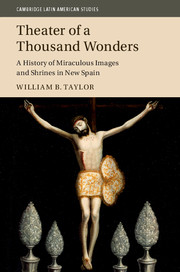Book contents
- Frontmatter
- Dedication
- Contents
- List of Figures
- List of Maps
- List of Tables
- Preface and Acknowledgments
- Archive Abbreviations
- Introduction
- Part I Bearings: Historical Patterns and Places of Image Shrines
- Part II Soundings: Divine Presence, Place, and the Power of Things
- 5 Making Miracles
- 6 Relics, Images, and Other Numinous Things
- 7 Religious Prints and Their Uses
- 8 Placing the Cross in Colonial Mexico
- 9 Pilgrims, Processions, and Romerías
- Conclusion
- Appendix 1 Colonial Image Shrines
- Appendix 2 When Shrines Began
- Appendix 3 Other Saints
- Index
9 - Pilgrims, Processions, and Romerías
from Part II - Soundings: Divine Presence, Place, and the Power of Things
Published online by Cambridge University Press: 05 September 2016
- Frontmatter
- Dedication
- Contents
- List of Figures
- List of Maps
- List of Tables
- Preface and Acknowledgments
- Archive Abbreviations
- Introduction
- Part I Bearings: Historical Patterns and Places of Image Shrines
- Part II Soundings: Divine Presence, Place, and the Power of Things
- 5 Making Miracles
- 6 Relics, Images, and Other Numinous Things
- 7 Religious Prints and Their Uses
- 8 Placing the Cross in Colonial Mexico
- 9 Pilgrims, Processions, and Romerías
- Conclusion
- Appendix 1 Colonial Image Shrines
- Appendix 2 When Shrines Began
- Appendix 3 Other Saints
- Index
Summary
What most distinguishes a shrine from other churches is that it is the object of pilgrimage; it draws people from beyond the immediate vicinity to a sacred place where devotees believe that God has shown His presence and special favor. But the meaning of pilgrimage and cognate terms in other languages is not as straightforward as “leaving home on a spiritual journey”; and even when scholars share an interest in large-scale journeys to a Christian sacred place, they have disagreed about what is going on. Beyond the many meanings of “pilgrimage” in our time, the ways people used the term hundreds of years ago also varied. And we rarely know exactly what pilgrims did and thought on their journeys.
Nearly all the colonial pilgrimages I can identify were short in duration and distance, directed to a nearby image shrine or other sacred place. They were not much like the great medieval and early modern Christian journeys of personal atonement along an established route of shrines leading to one of the great destinations – Compostela, Rome, or Jerusalem. From my early readings, including Victor Turner and the vast devotional literature for Our Lady of Guadalupe at Tepeyac, this was a surprise. Distant journeys of faith may have been a larger part of the story of pilgrimage in New Spain than I could document from the paper trail since ecclesiastical and civil authorities focused on regulating what went on at shrines more than on transit to and from them. On the other hand, colonial officials had good reasons to track long-distance commerce and what they regarded as vagrancy, and they did so without much attention to pilgrims.
After a few lines about the state of play in Christian pilgrimage studies and how the term pilgrimage is used, this chapter centers on how and why short journeys to sacred places were so important in the territory of New Spain until the mid-nineteenth century, and closes with an approach to further study. Again, sources and their uses are as much at issue as the patterns in sacred journeys over time that can be found in them.
- Type
- Chapter
- Information
- Theater of a Thousand WondersA History of Miraculous Images and Shrines in New Spain, pp. 502 - 550Publisher: Cambridge University PressPrint publication year: 2016



